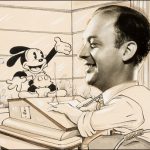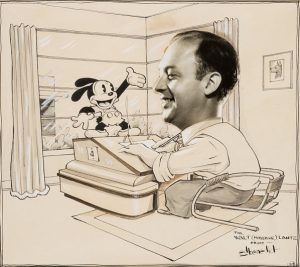


 Universal Pictures wanted to issue cartoons along with their features and shorts. Uncle Carl Laemmle decided to go with people who knew cartoons, rather than engage in his usual nepotism. He went first with Disney, through Winkler, for the start-up of the series, “Oswald the Lucky Rabbit” – but Disney had been getting $2,250 per each cartoon. Disney wasn’t seeing as much of the profits as he would like, and went to New York, seeking an increase to $2,700. Winkler instead offered him a 20% pay cut to $1,800. And she had been making overtures to most of Disney’s staff artists, and managed to get most of them to defect. Many of those who remained on Winkler’s staff would become the core of what would be the Looney Tunes crew for Harman-Ising.
Universal Pictures wanted to issue cartoons along with their features and shorts. Uncle Carl Laemmle decided to go with people who knew cartoons, rather than engage in his usual nepotism. He went first with Disney, through Winkler, for the start-up of the series, “Oswald the Lucky Rabbit” – but Disney had been getting $2,250 per each cartoon. Disney wasn’t seeing as much of the profits as he would like, and went to New York, seeking an increase to $2,700. Winkler instead offered him a 20% pay cut to $1,800. And she had been making overtures to most of Disney’s staff artists, and managed to get most of them to defect. Many of those who remained on Winkler’s staff would become the core of what would be the Looney Tunes crew for Harman-Ising.
If you went to see one of Universal’s first big-scale musicals, Broadway (1929), you might have seen one of the Winkler Oswalds on the same bill. Winkler got surprised, however, when Universal itself pulled the rug out from under her, taking over the series itself, and assigning the series to Walter Lantz, a veteran himself of several years, having produced a series of cartoons starring himself and animated characters in “Dinky Doodles”, as well as Colonel Heeza Liar episodes, “Unnatural History” cartoons, and Jerry on the Job, among others. Lantz’s unit got going pretty strongly, although the cartoons were not artistic world-beaters. They were sufficient to fill out the program at the local theater. One suspects that they were not too concerned with problems with the international market, as initial dialog consisted only of squawks and squeaks. The first two titles below in fact include no voice for Oswald whatsoever, his “talking” performed with a generally out-of-sync slide whistle.
Oil’s Well (9/16/29) – Oswald and family are prospecting for “black gold” – petroleum. Oswald seems to have a plane that can double as a car, and eventually, he does bring in a gusher. The characters appear on a version of the older-style Universal trademark at the end. Song: “I’m Wild About Horns On Automobiles That Go ‘Ta Ta Ta Ta’” Recorded as “Eddie Cantor’s Automobile Horn Song” by Eddie Cantor on Victor (the flip side of “I Faw Down and Go Boom”). A dance version was issued by Billy Hays for Victor, issued in the “Old Familiar Tunes” Country catalog, possibly on a regional basis. A version appeared on Cameo, Romeo, and Lincoln by Jack Kaufman, which may also have appeared under a pseudonym on Perfect and Pathe. Harry Reser’s Syncopaters got it for Columbia. Billy Jones and Ernest Hare issued a low-fidelity version for Grey Gull under their team name, The Happiness Boys. And there was a version cut in Buenos Aires by Caravelli and his Orchestra, issued on Argentine Victor. An unknown master, probably from American Plaza label and dubbed onto an 8″ format, was issued in England by Edison Bell Radio under the generic name “The Blue Jays” – the vocalist is definitely Billy Murray, and the banjo solo would suggest a second session by Harry Reser’s Orchestra.
Permanent Wave (9/29/29) – Oswald is rowing over and through the waves, in the wake of a larger boat. He winds up on the boat, whose master is Putrid Pete. They encounter a siren on the beach, who dances a jerky hula to “On the Beach at Waikiki” (a song we’ve encountered before from other studios). Oswald runs on the waves to get together with this dancer. Song: “Dream Kisses”, a 1927 pop which is heard over the last gag and iris out. Recordings include the Troubadours on Victor, and The Ipana Troubadours (no relation) directed by Sam Lanin on Columbia. In fact, Sam also moonlighted with a version as The Gotham Troubadours on Okeh. A vocal version was issued by Kitty Connor (The Girl Baritone) on Columbia. Tom Timothy and his Frivolity Club Orchestra issued only a small number of total sides, including this song on Cameo. Fred Rich issued a dance version on American Regal and related budget labels. Milton Charles issued a pipe organ version on Columbia. Harry Bidgood issued a British dance version on 8″ Broadcast.
Hurdy Gurdy (11/24/29) – Putrid Pete is playing a hurdy gurdy or street organ, one which requires a lot of action in the shoulders. The instrument, actually orchestrated by a mouse inside on a miniature piano, is given a keyboard-like sound on some passages, and a pipe organ sound on others. Oswald happens along to listen, blowing bubble gum, and drops a wad of it on the sidewalk. Pete’s monkey gets her foot stuck in the goo, and eventually is wrapped up in the mess tighter than a mummy. Vengeful Pete lassos Oswald around the neck, and forces him to perform monkeyshines as a substitute. They pass the upper-floor apartment of Oswald’s girlfriend, and Oswald, elevated up to the window to obtain coins for Pete, pulls a switcheroo, tying the leash to the leg of a bathtub in which a fat hippo is bathing. When Pete yanks the leash, the hippo and tub land on him with crushing force. Pete engages in quite a lot of brick tossing at our hero, but Oswald bats his brickbats back, using the hurdy gurdy as a bat to swing, and conking Pete, who staggers in an interesting shot. with buildings seeming to bend around him in a dizzy daze, then finally collapses. Cue the iris-our sloppy kisses. Song: “Washboard Blues” was first released by Hitch’s Happy Harmonists on Gennett, with piano by composer Hoagy Carmichael. Hoagy was brought to the Victor studios to play and sing a version with the Paul Whiteman band. while one of Whiteman’s vocalists was listening in and trying to learn the song for backup vocal and performance purposes – Bing Crosby. Red Nichols and his Five Pennies recorded a version for Brunswick in 1926, and another issue appeared on Vocalion. In early 1932, there was a 12″ Brunswick version (also issued on an ARC Theater Record) recorded by the Casa Loma Orchestra with vocal by Connie Boswell.
Broadway Folly (3/3/30) – Oswald drives up to the curb in front of a night club where he’s going to dance., and after a brief confrontation with the colored valet (who he refers to as “Sambo”, folds up his car into pocket size. A toddler nearby is going into various locations on Broadway looking for his father (Pete), who has disappeared in already intoxicated state into a saloon. The kid gets negative responses to his inquiry all around. Oswald tap dances to the melody of “By Heck”, and a ragged band plays “Alexander’s Ragtime Band”. The action eventually takes up the entire building from basement to penthouse. The building finally falls apart, and the baby is still looking for his papa in what looks like an Andy Gump, but finds it’s a telephone booth, with a guy inside complaining in fractured Yiddish. Song: “Hittin’ the Ceiling”, from the 1929 Universal Musical, Broadway. The song was recorded by Paul Specht’s Orchestra for Columbia, and Nat Shilkret and the Victor Orchestra for Victor (embed below). Okeh gave it to tall Texan Smith Ballew and his Orchestra. The Picadilly Players (a group fronted by Mel Morris) issued an Edison needle cut. Arthur Ross and his Westerners (probably a Ben Selvin group) issued an acoustical on Harmony. A British issue appeared by the Rhythmic Troubadours on Regal. Jay Whidden (an American bandleader recording in Europe) also issued a version on Imperial. The lyric in some parts suggests aviation, but seems to really refer to boozing it up – the context in which Putrid Pete seems to take it.
The Hash Shop (4/14/30) – Oswald is the waiter at a hash house, where the customers are not too particular about their food (or they wouldn’t be here), but want it now. Most of the gags are built around the food served – spaghetti used as strings of banjo and guitar, for example. Song: “Freshie”, a 1926 Collegiate fox trot. Recorded for Victor by Waring’s Pennsylvanians (at the Shrine Auditorium, getting a very “large” room sound), and Earl Gresh and his Gangplank Orchestra on Columbia. Cameo issued a version by the Varsity Eight – actually the California Ramblers with personnel including Adrian Rollini on bass sax. Said Ramblers also cut a version as the Golden Fate Orchestra for Edison Diamond Disc.
The live action, all color spectacular, The King Of Jazz (4/20/30) featured a landmark piece of animation for the studio – the first animated sequence in color, depicting a comic jungle adventure detailing how Paul Whiteman came to be “crowned” as the King of Jazz. Filmed in two-strop Technicolor, it even features a one-scene cameo for Oswald. Paul basically is pursued by a lion while hunting in Africa, but tames the lion by playing music for him. Some gags from this short sequence would be lifted almost verbatim by Harman and Ising for the early Bosko cartoon, Congo Jazz (including a swaying palm tree that swirls its cocoanuts around like a woman’s anatomy, until one of them detaches, conking Whiteman on the head). There are some musical quotations within the short: First, a spiritual, with Bing Crosby singing for Paul onscreen, in “My Lord Delivered Daniel”. “Music Hath Charms” was an original number, featured first over the titles of the feature sung by Crosby, then in instrumental form as part of the score for the animated sequence. Oddly, when Crosby recorded the soundtrack, he was spending his evenings in jail on a sentence for public drunkenness – but was being let out during the day to record his numbers. Neither of these musical pieces seems to have been recorded outside of the film itself.
Hell’s Heels (6/2/30) – This is a Western takeoff, parodying “Hell’s Hinges”, a famous and realistic early outdoor talkie, later remade as Three Godfathers. Oswald and several pals seem to be living outside the law in the badlands, and afraid to go back to town, as ominous warnings confront Oswald from the shadows of signposts. Eventually, Oswald is the only one of the three to manage a way back without paying the consequences. Songs: An original, “We’re Going To the Desert” – No known recordings. This cartoon would also gave the distinction of probably being the first to present as accompaniment to end credits a small chorus of singers repeating the phrase “Boop Boop a Doop” three times, followed by the line “That’s Oswald!” This ending coda would become customary for quite some time to follow. Whether intended to mimic Helen Kane, Max Fleischer, or simply capitalizing on the general popularity of the phrase, is unknown.
My Pal Paul (6/16/30) – Made in the wake of promoting “The King of Jazz”. Oswald’s efforts to be a musician meet with universal ridicule, and Oswald attempts to do himself in. Paul Whiteman happens by in his car, and prevents the suicide, lending Oswald an ear. Paul is pictured as a very stocky individual. Oswald tries to show his musical stuff – mostly by converting parts of Paul’s car into instruments. After wanton destruction of the vehicle, Paul and Oswald refer to each other sarcastically as “My pal”, but give each other the razz. Songs: “Song of the Dawn”, “It Happened in Monterey”. “Ragamuffin Romeo”, “A Bench In the Park”. and “Happy Feet” – all from “The King of Jazz”, and all recorded by Whiteman for Columbia. Victor gave George Olsen “It Happened in Monterrey” and “Song of the Dawn. Leo Reisman got “Happy Feet” for Victor, with guest trumpeter Bubber Miley. Cab Calloway got to do “Happy Feet” for Banner and the dime store labels. John Bowles (who appeared in the picture) recorded “It Happened in Monterey” and “Song of the Dawn” as a vocal record for Victor. There were other covers, but te above will suffice for samples of five songs at the same time.
NEXT TIME: More early Oswald next time.